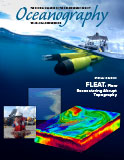Article Abstract
High levels of turbulent mixing have long been suspected in the Samoan Passage, an important topographic constriction in the deep limb of the Pacific Meridional Overturning Circulation. Along the length of the passage, observations undertaken in 2012 and 2014 showed the bottom water warmed by ~55 millidegrees Celsius and decreased in density by 0.01 kg m–3. Spatial analysis of this first-ever microstructure survey conducted in the Samoan Passage confirmed there are multiple hotspots of elevated abyssal mixing. This mixing was not just confined to the four main sills—even between sills, the nature of the mixing processes appeared to differ: for example, one sill is clearly a classical hydraulically controlled overflow, whereas another is consistent with mode-2 hydraulic control. When microstructure casts were averaged into 0.1°C conservative temperature classes, the largest dissipation rates and diapycnal diffusivity values (>10–7 W kg–1 and 10–2 m2 s–1, respectively) occurred immediately downstream of the northern sill in the eastern and deepest channel. Although topographic blocking is the primary reason that no water colder than Θ = 0.7°C is found in the western channel, intensive mixing at the entrance sills appeared to be responsible for eroding an approximately 100 m thick layer of Θ < 0.7°C water. Three examples highlighting weak temporal variability, and hence suggesting that the observed spatial patterns are robust, are presented. The spatial variability in mixing over short lateral scales suggests that any simple parameterization of mixing within the Samoan Passage may not be applicable.

